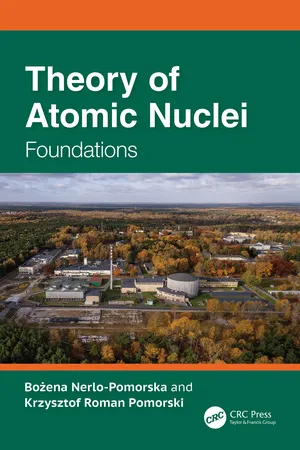
- English
- ePUB (mobile friendly)
- Available on iOS & Android
About this book
The dimension of a typical atom is 100.000 times larger than the size of its nucleus, however, around 99.975% of the mass of an atom is concentrated in its nucleus. This is why nuclear theory is sometimes called the theory of everything. Theory of Atomic Nuclei: Foundations selects some fundamental problems of the theory of atomic nuclei at low energy. It reviews specific nuclear physics issues in terms of historical development and evolution into more extended theories, which nowadays constitute complete parts of nuclear science. The book allows the reader to understand the structure of the nucleus, i.e., the mechanism that rules in this subatomic world. The book is intended for graduate physics students at universities and nuclear sciences and engineering students at technical universities. It can also be helpful for PhD students and junior researchers in nuclear physics. The book is based on lectures on the theory of atomic nuclei given by the authors at the Maria-Curie Sk?odowska University in Lublin and at doctoral schools in Poland, France, Germany, the Czech Republic, and China in recent years. It is based mostly on original scientific papers and extensive monographs on nuclear theory.
Key Features:
- Written as a compact introduction to theories of the atomic nucleus
- Despite its compact form, the book acquaints the reader with the basic nuclear models and helps them better understand them
- Provides the reader with a foundation to go on and navigate contemporary theories or models of the atomic nucleus independently and in more detail
Frequently asked questions
- Essential is ideal for learners and professionals who enjoy exploring a wide range of subjects. Access the Essential Library with 800,000+ trusted titles and best-sellers across business, personal growth, and the humanities. Includes unlimited reading time and Standard Read Aloud voice.
- Complete: Perfect for advanced learners and researchers needing full, unrestricted access. Unlock 1.4M+ books across hundreds of subjects, including academic and specialized titles. The Complete Plan also includes advanced features like Premium Read Aloud and Research Assistant.
Please note we cannot support devices running on iOS 13 and Android 7 or earlier. Learn more about using the app.
Information
Table of contents
- Cover Page
- Half-Title Page
- Title Page
- Copyright Page
- Dedication Page
- Contents
- Preface
- Introduction
- Chapter 1 Nuclear forces
- Chapter 2 Two body problem
- Chapter 3 Nuclear matter
- Chapter 4 Independent particles model
- Chapter 5 Macro-micro method
- Chapter 6 Average single-particle potentials
- Chapter 7 Self-consistent methods and density functionals
- Chapter 8 Residual forces in nuclei
- Chapter 9 Superconducting model of nuclei
- Chapter 10 Deformed nuclei
- Chapter 11 Rotation of atomic nuclei
- Chapter 12 Collective vibrations of nuclei
- Chapter 13 Generalized Bohr Model
- Chapter 14 Decays of atomic nuclei
- Chapter 15 Generator coordinate method and nuclear dynamics
- Bibliography
- Index